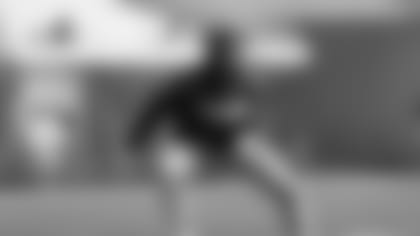Bryan Pittman has made a name for himself as one of the best long snappers in the league. The sixth-year pro, who has started every game for the Texans since joining the team in 2003, snaps with precision and consistency and blocks effectively in Houston's schemes.
However, Pittman's duties often are overlooked because he does not garner stats and remains far from the end zone. His job, though, is extremely vital to the team's success on special teams.
Pittman explains why and discusses the art of the long snap. He divides the long snap into three stages: grip, stance and motion.
1. Grip: Most long snappers position the ball so that the power hand (in this case, the right hand) grips the ball and the hand is turned under the ball. The back of the hand faces the ground and the laces are to the left. The fingers of the right hand provide stability and velocity. The left hand can be used to guide the ball and add rotation.
"Essentially, the long snap is a quarterback pass or a throw, but the big difference is that you are obviously upside down and you are going from the ground," Pittman said. "So the grip is just like how a quarterback would grip it. The only difference that I have is that I take my right index finger and I slide it parallel to the seem of the ball, and what that does is it helps keep the trajectory of the ball low so that it doesn't sail high."
{QUOTE}2. Stance: Stability and balance are crucial to the stance. The snapper has to have his feet slightly wider than his hips and he has to be to flex his hips to garner power. A powerful snap comes from the hip flexors. The long snapper's arms are extended to almost full extension with a little bend in the elbows.
"You want to be at a comfortable distance, feet a little more than a shoulder width apart," Pittman said. "All these techniques are going to be different depending on your skill and comfort level. What I do is start out with my feet a little more than shoulder width apart. The ball's about a foot and a half out in front of me.
"You just want to have equal base and balance in your legs. And you want to have a flat back, so you can put a 2x4 on your back when you are bent over, good extension with the arms, let the ball be right in front of you – not to the right or the left because that's the way the ball is going to go – to wherever it's lined up."
3. Motion: The long snapper begins his motion by spiraling the ball into action and pulling his hands through his legs. The snapper's technique must be forceful and fluid. The player adds power using his hips to get behind the ball.
The final aspect of the snap is the motion itself," Pittman said. "It's just one very quick, fluid motion. You don't want to have any hitches, stops, hiccups or anything. It's just quick and fluid."
Pittman's note: "One interesting note that I'll give you about the difference between a college snapper and a professional snapper is the hardest part of the snap, which is the transition from the snap to the block.
"In the professional scheme, you are required to do more than snap the ball. You've got to actually read the front, determine which way you are going to go, snap the ball and then block your man, sometimes two men. And sometimes you might have to change your feet and block the other way. To me that is the biggest difference between college snappers and professional, to be able to do that transition and have the confidence to do it every down."














